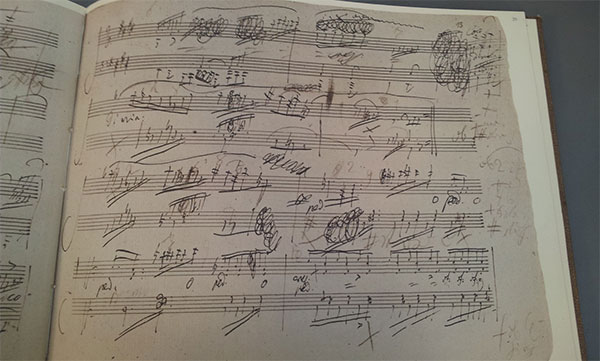The real challenge with composers who lived hundreds of years ago is determining what is authentic. One piece that comes to mind is the famous Beethoven Ecossaise in G major. There’s one part where you hear a strange chord which is found in many editions. Yet other editions omit this odd chord. Are we correcting Beethoven? That takes a lot of guts! But if you listen to it, you can hear for yourself the altered version compared to the original autographed score. Whether it’s correct or not, did Beethoven make a mistake or did the editors make the mistake? It is really tough to know from so long ago.
A lot of times what is oftentimes correct is what doesn’t sound as good! This is because editors throughout the ages try to make things sound right and take some liberties, some of which can be traced to very early published editions. If you’ve ever seen Beethoven’s calligraphy, you’ll know why deciphering Beethoven’s scores can be such a tough job:

I have another example for you, the Nocturne in E Minor of Chopin which was published posthumously (after his death). It’s got a really strange harmony in one place in some urtext editions (which are supposed to be authoritative) and I want you to listen to it as written so you’ll hear what I’m talking about. Then I’ll play it the way it’s found in many other editions. Which one is authentic? To tell you the truth, I have not researched this beyond these editions. I welcome comments from all of you. In the middle section of the Nocturne there is a strange note that I want you to listen to. You can listen to the video to hear the original urtext compared to the edited version to hear for yourself how the urtext sounds quite strange.
Even though I heard this piece many times growing up, I only studied it for the first time quite recently. I simply took out my urtext score to learn it. One time I was playing it for my sister and she told me that there’s a wrong note in a lot of editions. As soon as she said that, I knew it wasn’t how I remembered hearing it before! So, I ended up playing it the corrected way which sounds better even though it is probably not authentic!
The last example I’m going to bring to your attention is truly an almost epic fail in my opinion. One of the greatest sonatas of all time is the Liszt B Minor Sonata. Essentially it’s all played without pause and it’s about a thirty minute work. It’s absolutely monumental, and interestingly, there is an alternative ending that Liszt wrote first which ended incredibly heroically. Although the piece has incredible climaxes throughout, he pulled out all the stops for the end which has a huge display of technical skills. Clara Schumann (Robert Schumann’s wife) who Liszt was friends with just hated it and encouraged him to rewrite the ending which he did. The ending of the Liszt B minor sonata is what brings the whole work together because the work has all the heights and the depths imaginable, yet ends with solace. I don’t play the alternative ending, but there are recordings of it on YouTube you can listen to. I find it almost laughable because I am intimately familiar with the Liszt B Minor Sonata and to think that he could have ended it with this big, heroic ending with increasing excitement, is antithetical to what this whole piece is about. So I’m going to play just the ending which starts with a huge climax, then solitude that ends this thirty minute work. It’s truly a profound piece of music. If you’ve never heard it, it’s worth a listen. I think we owe it to both Franz Liszt and Clara Schumann for making it one of the milestone compositions in the piano repertoire. I would love your opinion. If you listen to other YouTube performances where they play the alternative ending that Liszt originally wrote, you will be amazed as I was!
Thanks for joining me, Robert@LivingPianos.com for this exploration. I hope you have enjoyed it and welcome your questions for future videos.








